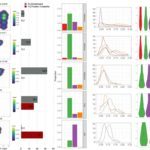Link to Pubmed [PMID] – 28985357
Nucleic Acids Res. 2017 Oct;45(18):10800-10810
Many studies using reporter assays have demonstrated that 3′ untranslated regions (3′-UTRs) regulate gene expression by controlling mRNA stability and translation. Due to intrinsic limitations of heterologous reporter assays, we sought to develop a gene editing approach to investigate the regulatory activity of 3′-UTRs in their native context. We initially used dual-CRISPR (clustered, regularly interspaced, short palindromic repeats)-Cas9 targeting to delete DNA regions corresponding to nine chemokine 3′-UTRs that destabilized mRNA in a reporter assay. Targeting six chemokine 3′-UTRs increased chemokine mRNA levels as expected. However, targeting CXCL1, CXCL6 and CXCL8 3′-UTRs unexpectedly led to substantial mRNA decreases. Metabolic labeling assays showed that targeting these three 3′-UTRs increased mRNA stability, as predicted by the reporter assay, while also markedly decreasing transcription, demonstrating an unexpected role for 3′-UTR sequences in transcriptional regulation. We further show that CRISPR-Cas9 targeting of specific 3′-UTR elements can be used for modulating gene expression and for highly parallel localization of active 3′-UTR elements in the native context. Our work demonstrates the duality and complexity of 3′-UTR sequences in regulation of gene expression and provides a useful approach for modulating gene expression and for functional annotation of 3′-UTRs in the native context.


